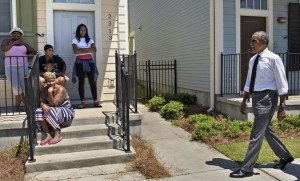
Hurricane Katrina 10 Years Later
Current Events –
Hurricane Katrina 10 Years Later
On the morning of August 29, 2005, Hurricane Katrina hit the Gulf Coast of the United States. Soon after, the levees broke in New Orleans, submerging the city underwater and killing more than 2000 people. In memory of that horrific disaster and in mourning of all those who lost their lives, President Obama traveled to Louisiana to mark the occasion.
Current Events
The president strolled door to door in the historic Treme section of New Orleans (America’s oldest African-American neighborhood). He then stopped in the Lower 9th Ward to speak to hundreds of residents assembled at a community center that was once under 17 feet of water.
“There’s something in you guys that is just irrepressible,” Mr. Obama said. “The people of New Orleans didn’t just inspire me, you inspired all of America.”
He held up the community center as “an example of what is possible when, in the face of tragedy and in the face of hardship, good people come together to lend a hand and, brick by brick, block by block, neighborhood by neighborhood, you build a better future.”
“Look at what’s happened here,” he declared, marveling at the transformation of a city that he said was once “dark and underwater.”
Still, Mr. Obama acknowledged that much remains to be done and certain areas of the city still suffer from high poverty.
“Our work here won’t be done when almost 40% of children still live in poverty in this city. That’s not a finished job. That’s not a full recovery,” he said. “There’s still too many people who haven’t been able to come back home.”
By some estimates, more than 100,000 African-Americans fled New Orleans following Hurricane Katrina — and have never returned.
“What that storm laid bare was another tragedy — one that had been brewing for decades,” Mr. Obama continued. “New Orleans had long been plagued by structural inequality that left too many people, especially poor people, especially people of color, without good jobs or affordable health care or decent housing. Too many kids grew up surrounded by violent crime, cycling through substandard schools where few had a shot to break out of poverty. And so like a body weakened already, undernourished already when the storm hit, there were no resources to fall back on.”
There is more to be done to confront “structural inequities that existed long before the storm happened,” he added.
Nearly 2,000 people died in New Orleans following Hurricane Katrina. Images of residents screaming for help from their rooftops, inside the Superdome and at the convention center are still fresh in most everyone’s mind. The memory of that date in history symbolizes the Bush administration’s failure at every level.







